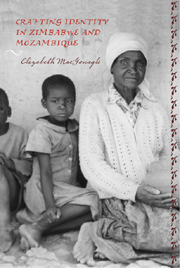Book contents
- Frontmatter
- Contents
- List of Illustrations
- Acknowledgments
- 1 A Mixed Pot: The Crafting of Identity
- 2 The Historical Landscape of Southeast Africa
- 3 Early Exchanges: Political and Economic Contexts
- 4 Ties That Bind: Social Structures and Cultural Practices
- 5 Keeping up Appearances: Identity and Adornment
- 6 Brewing Beer, Making Rain, and Holding Court
- 7 Memories and Identities in the Shadow of Ngungunyana
- 8 Past and Present in the Ndau Region
- Notes
- Glossary of Ndau and Portuguese Words
- Bibliography
- Index
- Rochester Studies in African History and the Diaspora
2 - The Historical Landscape of Southeast Africa
Published online by Cambridge University Press: 12 September 2012
- Frontmatter
- Contents
- List of Illustrations
- Acknowledgments
- 1 A Mixed Pot: The Crafting of Identity
- 2 The Historical Landscape of Southeast Africa
- 3 Early Exchanges: Political and Economic Contexts
- 4 Ties That Bind: Social Structures and Cultural Practices
- 5 Keeping up Appearances: Identity and Adornment
- 6 Brewing Beer, Making Rain, and Holding Court
- 7 Memories and Identities in the Shadow of Ngungunyana
- 8 Past and Present in the Ndau Region
- Notes
- Glossary of Ndau and Portuguese Words
- Bibliography
- Index
- Rochester Studies in African History and the Diaspora
Summary
Kare haagari ari kare.
The past will never remain the past.
—Shona proverbA survey of the historical landscape suggests how to give meaning to identity formation and interactions between insiders and outsiders that occurred before formal colonialism took hold in southeast Africa. Although internal and external dynamics were both at play (and often intertwined), local populations shaped their own histories as agents of their own collective experiences. By looking at early written sources from Europeans who lived and traveled in the region, it is possible to trace the precolonial history of the Ndau since about 1500. Evidence of the development of identities from as early as the sixteenth century allows me to overturn the prevailing habit of dating African identities from the period of the Scramble for Africa in the late nineteenth century. In this chapter I turn to theoretical concerns that influence the study of ethnicity, identity, and history and then discuss the written record that informs a history of the Ndau from 1500 to 1900.
Ethnicity, Identity, and History
Previously, scholars and postcolonial leaders avoided questions surrounding ethnic identities on the continent. They tended to view ethnicity as a “retrogressive and shameful” topic, as Crawford Young notes, that could “summon forth from the societal depths demons who might subvert nationalism.” A popular phrase in Mozambique after independence, for instance, was “Down with tribalism!” Similarly, in neighboring South Africa ethnicity was viewed as the false creation of an apartheid state and feared as a divisive force.
- Type
- Chapter
- Information
- Crafting Identity in Zimbabwe and Mozambique , pp. 25 - 38Publisher: Boydell & BrewerPrint publication year: 2007



